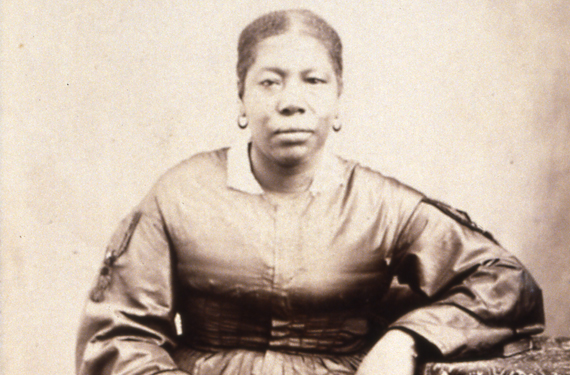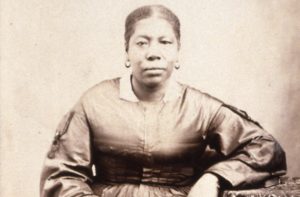
Jane Elizabeth Manning James fondly known as “Aunt Jane” was one of the first recorded African-American women to enter Utah. She was member of the Latter Day Saint Church and lived with Joseph Smith and his family for a time in Nauvoo, Illinois. She traveled with her husband to Utah, spending the winter of 1846–1847 at Winter Quarters. She petitioned the First Presidency to be endowed and sealed; as a result of her requests she was adopted as a servant into the Joseph Smith family through a specially created temple ceremony. Not satisfied to be an eternal servant in the Smith family, she continued to petition to receive her own temple endowment but was denied these rites during her lifetime. She was posthumously endowed by proxy in 1979.
Jane Elizabeth Manning James was born in Wilton, Connecticut, to Isaac and Eliza Manning. Although, late in James’ life her brother Isaac gave her birthday as May 11, 1813, there are source discrepancies that place her birthday anywhere from September 22, 1812, to the year 1820. The Mannings were a free family living in rural Connecticut, and Jane had at least four siblings including Isaac, Lewis, Peter, Sarah, and Angeline. At the age of six, Jane was sent away to live with the Fitches, a wealthy Caucasian family. She was raised by the Fitches’ daughter and lived with them for the next thirty years. Little is known about Jane’s life with the Fitches other than she worked as a servant: cooking, cleaning, and ironing, etc. While with the Fitches, Jane was also brought up as a Christian. She was baptized into the Presbyterian Church when she was about 14 years old. On March 1, 1835, Jane gave birth to a son, Sylvester.
In the fall of 1842, two LDS missionaries, one of whom was Charles Wesley Wandell, were preaching in the area. Although forbidden by her Presbyterian preacher, Jane recorded that she “had a desire to hear them. Jane was baptized into the Church of Jesus Christ of Latter Day Saints the following Sunday, and later acquainted many friends and family members with her new beliefs as well. A year later, Jane and eight other members of her family, including her mother, three brothers, two sisters, and a brother and sister-in-law- decided to move from their home in Wilton to Nauvoo, Illinois, in order to live among other members of their new faith. The group of nine began their journey with other Latter Day Saints under the direction of Wandell, but got separated from the group at Buffalo, New York, when they couldn’t afford to pay the train fare from New York to Ohio. Jane and her family traveled the remainder of their journey (approximately 800 miles) on foot. In her Life Sketch, recorded in 1893, Jane recalled that “We walked until our shoes were worn out, and our feet became sore and cracked open and bled until you could see the whole print of our feet with blood on the ground.” When Jane and her family arrived in Nauvoo, they were welcomed by Joseph Smith himself. Over the next year, her mother and siblings would establish their own homes. Jane, however, lived with the Joseph Smith family in Nauvoo until Smith’s assassination in 1846.
Jane had several unique experiences while living with the Smith family in Nauvoo. James recorded that often, as she went about doing the washing and cleaning for the Smiths, either Emma (Joseph’s wife) or Joseph’s mother (Lucy) would stop her and talk with her. One day while Jane was in Joseph’s mother’s room, the woman told her to “bring me that bundle from the bureau and sit down here.” According to Jane, she was shown the Urim and Thummim, the tools used by Joseph Smith to translate the Book of Mormon. Lucy then said to her, “You will live long after I am dead and gone and you can tell the Latter-day Saints that you was permitted to handle the Urim and Thummim”. Another time, Emma asked Jane if she would like to be adopted by and sealed to her and Joseph. Not understanding at the time, Jane said nothing. Emma encouraged her to think about it. Two weeks later, she asked Jane again, at which time Jane said “no m’am”. Jane would say later that she didn’t understand what that meant, or she would have taken the couple up on their offer. This early decision had a significant impact on Jane’s later life as a member of the Latter Day Saint church.
After Joseph Smith’s assassination in 1844, Jane resided in Brigham Young’s home. It was here where she met and married her husband, Isaac James. Isaac was born a free man and grew up in rural New Jersey. He converted to the Church of Jesus Christ of Latter Day Saints in 1839. At the time of his baptism Isaac was 19 years old, and became one of the earliest immigrants to Nauvoo.
When the Latter-day Saints began to migrate west in 1846, Jane prepared to move as well. Although many of her immediate family members, including her mother, three brothers, and two sisters, had joined the church, she was the only one who chose to move West with the main body of saints from Nauvoo. At the time of the James family’s departure, Jane was pregnant with a second son. Silas James was born at Hogg Creek, Iowa in June 1846. Jane (then pregnant with her second son), her husband Isaac, and Sylvester were part of the original group of Latter-day Saints to spend the winter of 1846–1847 at Winter Quarters, Nebraska. Jane and her family were part of the Ira Eldredge company, the first Mormon pioneer company to enter the Salt Lake Valley in September 1847. At the time of their settlement in the Salt Lake Valley, they made up a third of the 12 African Americans living in Utah, and were the only ones who were free.
Jane was the first documented African-American woman to come to the Utah Territory as a Mormon pioneer. The family’s first years in the valley were difficult: they lived in poverty and often did not even have the barest essentials for survival. Nevertheless, Jane exhibited remarkable charity and strength of character. In 1849, Eliza Lyman, a neighbor of Jane’s had literally no food to sustain her and her children until the harvest after she sent her husband on a mission to California. She records, however, that “Not long after Amasa had gone, Jane James, the colored woman, let me have two pounds of flour, it being half of what she had.” Despite trials, Jane’s life in Utah was punctuated by moments of joy. A daughter, Mary Ann, was born May 1848—the first black child born in Utah. Eventually things began to get better for the Mannings: by the mid 1860’s they were able to build a comfortable home and had acquired both farmland and animals, including an ox, horses, and a small flock of sheep By the end of 1865 the Jameses, while not wealthy, were fairly prosperous. Only four households in the area held more assets in 1865 than did the Jameses, while 31 held less. The family was growing quickly as well. Between 1848 and 1860 six children were born in the James family: Miriam, Ellen Madora, Jessie, Jerry, Isaac, and Vilate. Jane’s oldest son, Sylvester, was listed as a member of the Nauvoo Legion in 1861.

